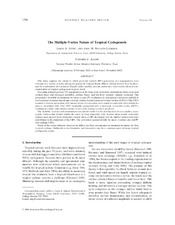| dc.creator | Sippel, Jason | |
| dc.creator | Nielsen-Gammon, John | |
| dc.creator | Allen, Stephen | |
| dc.date.accessioned | 2016-10-28T19:33:25Z | |
| dc.date.available | 2016-10-28T19:33:25Z | |
| dc.date.issued | 2006-07-01 | |
| dc.identifier.citation | Sippel, J., J. W. Nielsen-Gammon, and S. Allen, 2006: The multiscale vortex nature of tropical cyclogenesis. Mon. Wea. Rev., 134, 1796-1814. | en |
| dc.identifier.uri | https://hdl.handle.net/1969.1/158227 | |
| dc.description | © Copyright 2006 American Meteorological Society (AMS). Permission to use figures, tables, and brief excerpts from this work in scientific and educational works is hereby granted provided that the source is acknowledged. Any use of material in this work that is determined to be “fair use” under Section 107 of the U.S. Copyright Act September 2010 Page 2 or that satisfies the conditions specified in Section 108 of the U.S. Copyright Act (17 USC §108, as revised by P.L. 94-553) does not require the AMS’s permission. Republication, systematic reproduction, posting in electronic form, such as on a web site or in a searchable database, or other uses of this material, except as exempted by the above statement, requires written permission or a license from the AMS. Additional details are provided in the AMS Copyright Policy, available on the AMS Web site located at (https://www.ametsoc.org/) or from the AMS at 617-227-2425 or copyrights@ametsoc.org. | en |
| dc.description.abstract | This study explores the extent to which potential vorticity (PV) generation and superposition were relevant on a variety of scales during the genesis of Tropical Storm Allison. Allison formed close to shore, and the combination of continuous Doppler radar, satellite, aircraft, and surface observations allows for the examination of tropical cyclogenesis in great detail.
Preceding Allison’s genesis, PV superposition on the large scale created an environment where decreased vertical shear and increased instability, surface fluxes, and low-level cyclonic vorticity coexisted. This presented a favorable environment for meso-α-scale PV production by widespread convection and led to the formation of surface-based, meso-β-scale vortices [termed convective burst vortices (CBVs)]. The CBVs seemed to form in association with intense bursts of convection and rotated around each other within the meso-α circulation field. One CBV eventually superposed with a mesoscale convective vortex (MCV), resulting in a more concentrated surface vortex with stronger pressure gradients.
The unstable, vorticity-rich environment was also favorable for the development of even smaller, meso-γ-scale vortices that formed within the cores of deep convective cells. Several meso-γ-scale convective vortices were present in the immediate vicinity when a CBV developed, and the smaller vortices may have contributed to the formation of the CBV. The convection associated with the meso-γ vortices also fed PV into existing CBVs.
Much of the vortex behavior observed in Allison has been documented or simulated in studies of other tropical cyclones. Multiscale vortex formation and interaction may be a common aspect of many tropical cyclogenesis events. | en |
| dc.description.sponsorship | National Oceanic and Atmospheric Administration | en |
| dc.language.iso | en_US | |
| dc.publisher | American Meteorological Society | |
| dc.subject | hurricanes | en |
| dc.subject | tropical cyclones | en |
| dc.subject | vortical hot towers | en |
| dc.title | The Multiple-Vortex Nature of Tropical Cyclogenesis | en |
| dc.type | Article | en |
| local.department | Atmospheric Sciences | en |
| dc.identifier.doi | 10.1175/MWR3165.1 | |


